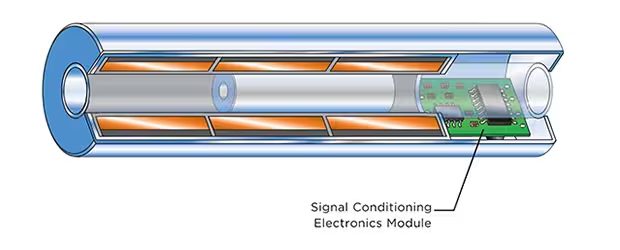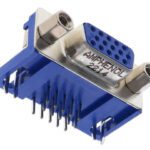What are LVDT sensors?
Meet the Connector: LVDT sensors
An LVDT (linear variable differential transformer) is a commonly used metrology tool. It is referred to as a sensor or transducer (a device that can transform one form of energy into another). In this case, it transforms linear motion into an electrical signal. Use of an LVDT is a highly accurate method for determining linear distances, applied in a wide range of industries for various applications, including vibration detection, stress testing, and detecting displacement that occurs with actuator movement.
LVDTs are electromechanical (they include electrical and mechanical processes). They are passive devices (they can store or dissipate energy but cannot generate it). They are inductive (they can store energy as an electromagnetic field).
An LVDT requires an external energy source to operate. It converts energy into a readable signal used to determine linear displacement (movement along a single axis).
How it is constructed

Source: TE Connectivity
The LVDT has a cylindrical shape. It is made up of a hollow, non-magnetic, insulated tube. Three high-density glass-filled coils (or windings) wrap around the core inside the tube. The coil in the center is called the primary coil. The other two are called secondary coils and are equidistant from the primary coil on either side.
The secondary coils are in a connected series. The “D” in the name (“differential”) refers to these coils being electrically 180° out of phase with one another.
The cylindrical core is made of soft iron and is ferromagnetic (highly susceptible to magnetization).
How it works
A push rod is attached to the core and to the body whose linear movement (positioning displacement) is being measured. The rod and core slide along the tube. The connection of the secondary coils creates an electrical output that equals the difference between their voltages. Constant alternating current (AC) is applied to the primary winding. This is known as the “primary excitation.” When the primary excitation interacts with the secondary coils, current and voltage are produced. When the primary coil is in the exact center, known as the null position, the magnetic flux to each of the secondary coils is equal. Because the secondary coils are 180° out of phase with each other, in this position the output voltage is zero. This is used to calibrate the LVDT.
A positive output voltage occurs when the linear movement causes the core to move toward the upper secondary coil and away from the lower secondary coil. The magnetic flux is then greater on the upper coil. The reverse occurs when the core moves down toward the lower secondary coil, resulting in lower induced magnetic flux on the upper secondary coil and creating a negative output voltage. The positive or negative value of the voltage output, therefore, indicates the direction of the body’s movement.
The advantages of LVDT sensors
LVDT sensors are known for their robustness and performance. Wear and tear is greatly reduced because there is no physical contact with the sensing element. Additional advantages include:
- Low energy consumption
- Consistent, highly accurate measurement
- Measurement possible even with limited space and access
- Consistently accurate results
Design Notes
Mounting
Lead wires or connection sockets. The secondary coils wired in series means the sensor has four wires or four connections in the connection socket. However, some LVDTs provide the secondary coil lead pairs separately.
Electrical properties
Initially, LVDTs were operated only by alternating current (AC). Today, technology allows for signal conditioning, which can occur inside the sensor’s housing using direct current (DC) without sacrificing the beneficial characteristics of the AC LVDT. However, the electronic materials of the signal conditioning modules have some limitations, such as the temperatures at which the DC LVDTs can operate.

Source: TE Connectivity
Other names
- linear displacement transducer
- linear position transducer
- linear displacement sensor
Markets and Applications
Markets: aerospace, automotive, industrial, medical (pharmaceutical), as well as electronics, energy, and environment applications.
LVDTs are primarily used to measure displacements ranging from fractions of a millimeter to several centimeters. They are also used to measure force, weight, and pressure. Examples of applications are measuring fluid levels, checking bearing alignment, assembly line inspection, checking SMC wafer height, and control of pill production.
Suppliers
LDVTs are available from many suppliers, including AMETEK, TE Connectivity, DigiKey, Heilind Electronics, Mouser Electronics, RS, TTI Inc., Honeywell, Keyence, Micro-Epsilon, Sensata, and others.
Related products
LVIT (linear variable inductance transformer)
Like this article? Check out our other Meet the Connector articles, our Sensors/Antennas Market Page, and our 2023 and 2024 Article Archives.
Subscribe to our weekly e-newsletters, follow us on LinkedIn, Twitter, and Facebook, and check out our eBook archives for more applicable, expert-informed connectivity content.
- Sealing Success: Overmolding for More Secure Connections - April 23, 2024
- Medical Cable Assemblies Product Roundup - April 23, 2024
- Mezzanine Connectors Product Roundup - April 16, 2024






